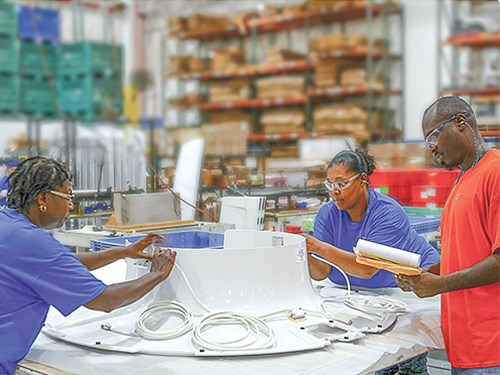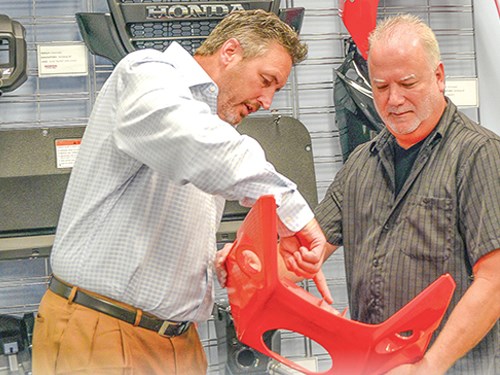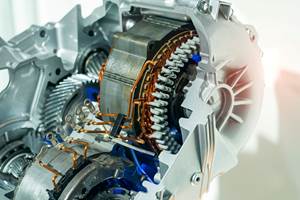Vaulting to Number One Among Heavy-Gauge Thermoformers
For Wilbert Plastic Services, it’s all about bringing together design and engineering to add value for customers.
For a company whose roots go back to 1886 in the funeral-services industry, there is a lot of vitality and creativity in the air at Wilbert Plastic Services. Headquartered in Belmont, N.C., Wilbert today stands as North America’s leading heavy-gauge custom thermoformer, with more than 110,000 ft2 of manufacturing space in Belmont and another 310,000 ft2 in White Bear Lake, Minn. The combined operations employ nearly 240 people and produce complex, highly engineered parts for a range of industries, including automotive, truck, agriculture, aerospace, recreation, and healthcare.
Wilbert also has five facilities devoted to injection molding that account for about 832,000 ft2 and employ around 1130. All of Wilbert’s processing facilities are TS 16949 and ISO 9001 certified. The firm also has a sales and engineering office in Troy, Mich. to serve the automotive market.
Back in 1886, Wilbert was founded by Ferdinand Haas to support the concrete burial vault industry. A burial vault is a lined and sealed outer receptacle that houses the casket and protects it from the weight of the earth and heavy maintenance equipment that will pass over the grave. It also helps resist water and preserves the beauty of the cemetery or memorial park by preventing the ground from settling.
These burial vaults need to be lined. Initially, liner materials consisted of tar and asphalt. In 1965, Wilbert engineers began looking at plastic to replace the tar and asphalt, and ultimately developed a process to create 0.5-in.-thick ABS and PS thermoformed liners and lids. In 2008, Wilbert spun off that business to create Wilbert Funeral Services. The vault liners are still made by Wilbert Plastic Services at its two forming plants.
Wilbert today is a privately held business with “a multitude of shareholders,” says Greg M. Botner, who in 2008 was appointed president and CEO after serving a number of years on the company’s Board of Directors. Heathcare equipment is the biggest part of Wilbert’s thermoforming business, comprising about 15-18%. Wilbert is also active in automotive, appliances, consumer products, and car seats for children. Since 2010, overall company sales have nearly doubled to approximately $285 million, Botner reports. He estimates that about 35% of that growth has been through acquisitions on the injection molding side.
Still, that means 65% of the firm’s growth has been organic and in part the result of a rebounding economy. “The landscape is always changing and our strategies are evolving with it,” states Botner. “We are shipping two to three times more SKUs now than ever before. But we’re not a ‘make-everything’ kind of company. We’ve exited low-growth markets and strategized toward businesses we
wanted to pursue and customers with which we wanted to partner.”
COMPREHENSIVE SERVICES
In both Minnesota and North Carolina, Wilbert’s technology portfolio includes a variety of thermoforming technologies, among them vacuum, pressure, pressure-assist, twin-sheet, and composite reinforced. “Across the industries we serve, customers want market focus on manufacturing expertise,” Botner says. “That’s where we live and breathe. The depth of our technology and the scope of our engineering capabilities allow us to engage a project early in the development phase. We’ve been able to turn around jobs in four to five weeks with 500-600 units in many different configurations. This is the type of value that our customers value. And if we can’t bring value to a project, then we don’t want to be there.”
Wilbert’s customers are a veritable Who’s Who among the OEM elite, and include such names as GE Healthcare, Baxter, Honda, Peterbilt, Kenworth, and John Deere.
In thermoforming, Wilbert has a full suite of product design and engineering services and tools. These include a variety of design software, including Pro-E Wildfire, CATIA V-5, UGNX, AutoCAD,
and IDEAS. In-house project engineers also utilize Solidworks for reviewing CAD models and drawings in any IGES or STEP file translation. Moreover, Wilbert’s FEA and mold-flow simulation capabilities, as well as its “live” WebEx CAD review, make it convenient for customers to communicate, analyze, and work with Wilbert to develop, optimize, and validate their products.
“The farther upstream we are involved in the project, the better result for both us and the customer,” adds Botner. In an example of this, he recalls the case of a customer that was launching a new harvester/combine that was made primarily of metal. “We blew apart the assembly and showed a number of parts where metal could be replaced with plastic. We looked at about 20 different parts, and converted four. That’s an effective result.”
Those who consider parts made by heavy-gauge forming to be less eye-popping than high-speed ther- moformed packaging might want to pay Wilbert Plastic Services a visit. Included in its product line is a series of CARB- and EPA-compliant fuel tanks made by twin-sheet pressure forming. Wilbert also forms highly aesthetic cargo liners, twin-sheet doors for refrigerated trucks, a variety of heavy-truck exterior components, automotive liners and trim, and wheel liners, decks, and cab hoods for heavy trucks.
Wilbert Plastic Services has also developed a manufacturing process called Composite Reinforced Thermoforming (CRT) that takes advantage of the strengths of thermoforming and composites. Combining thermoforming with the structural integrity of composite reinforcement allows for the production of a struc- turally reinforced product on the backside of the thermoformed skin. CRT parts have a non-painted Class A finish in solid color, solid color with clear protection, metallic with clear top layer, chrome, or any innovative pattern design such as a carbon mesh. Moreover, CRT is a “green” process that eliminates VOCs in the composite resins and VOC’s from post-painting. CRT also offers lower tooling costs, making it an excellent choice for low- volume production parts requiring structural performance plus high-quality appearance. Parts made by CRT also use less resin, resulting in lower part weight.
Lately, Wilbert Plastics has received a lot of attention for an MRI medical enclosure that was the Gold winner in the heavy-gauge innovation category at last year’s Society of Plastics Engineers’ Thermoforming Parts Competition. The enclosure was made utilizing controlled-positive tooling for vacuum forming and negative tooling with action for pressure forming. The enclosure is formed from a variety of sheet materials that include PVC/acrylic, PC/ABS, and PC. Undercut features on the tooling served to hide trimmed edges on parts at transition locations.
The enclosure consists of multi-component bonded assemblies that provide functional aspects, aesthetics, and serviceability. For this project, molds, secondary CNC/robotic fixtures, gauging, and assembly fixtures were built by Wilbert using 3D data; secondary tooling was built concurrently with molds to minimize the overall timeline. Locations of the bonded assembly components and mechanical fasteners were all based on the CAD geometry. This included all latching and hinging hardware, which ensures correct alignment in the end result. Each enclosure kit is packaged complete and shipped ready to be fitted.
ON THE PLANT FLOOR
Wilbert is among a handful of thermoformers that make some of its own sheet—PS, ABS, and TPO, primarily—shipping it to North Carolina from Minnesota. Tools and assembly fixtures also come from the Minnesota plant. Mold cavities and cores are sourced from outside vendors, with water and vacuum lines fitted in North Carolina, states Dwayne Laws, plant manager. Wilbert runs at draw depths to 30 in., with in-house developed plugs.
The plant in North Carolina houses 10 three- and four-station rotary thermoformers, 10 CNC routers, and four robotic trimmers (three of them with dual arms). The facility is also equipped with ovens to redry hygroscopic sheet materials like ABS.
The plant runs a mixture of low- and high-volume parts; higher-volume parts are generally made in forming cells. Formers, grinders, and saw trimmers are inside the cells, with robotic trimming stations nearby. All CNC robotic routers have automatic tool changing. Trimming used to be done manually by as many as eight employees but is now primarily automated.
Assembly is entirely manual. At each assembly station, kits containing all components to be fastened are all in one place, along with schematics or actual photos of what the part should like once put together, says Laws.
The hub of the manufacturing operation is Wilbert’s Plant Intelligence Center, where an ERP software system supplied by IQMS, Paso Robles, Calif., tracks the status of each project in real time. Wilbert takes quality control seriously. Companywide, its quality-assurance team has 650 years of combined manufacturing and quality experience. Its team boasts 10 quality engineers with Six Sigma Black Belts and ISO/TS 16949 Lead Auditors.
Laws notes that Wilbert has also developed its own training programs and videos specific to heavy-gauge thermoforming, including four modules for basic training, and four for advanced.
In North Carolina, Wilbert also does its own programming on its robotic arms and refurbishes all equipment except where major electrical issues are involved. It builds trim and secondary fixtures and gauges in-house. And, Laws notes proudly, apart from cafeteria trash, it landfills nothing. It regularly collects and resells all production scrap.
Related Content
LFT-D Thrives in Automotive and Other Durables
Teijin Automotive acquires its 10th direct long-fiber thermoplastic system as demand for this technology soars.
Read MoreAutomotive Awards Highlight ‘Firsts,’ Emerging Technologies
Annual SPE event recognizes sustainability as a major theme.
Read MoreSPE Automotive Awards Applaud ‘Firsts’ and Emerging Technologies
The 51st annual SPE Automotive Innovation awards gave nods to several ‘firsts’ and added alternative vehicle systems category.
Read MorePEEK for Monolayer E-Motor Magnet Wire Insulation
Solvay’s KetaSpire KT-857 PEEK extrusion compound eliminates adhesion and sustainability constraints of conventional PEEK or enamel insulation processes.
Read MoreRead Next
Advanced Recycling: Beyond Pyrolysis
Consumer-product brand owners increasingly see advanced chemical recycling as a necessary complement to mechanical recycling if they are to meet ambitious goals for a circular economy in the next decade. Dozens of technology providers are developing new technologies to overcome the limitations of existing pyrolysis methods and to commercialize various alternative approaches to chemical recycling of plastics.
Read MoreWhy (and What) You Need to Dry
Other than polyolefins, almost every other polymer exhibits some level of polarity and therefore can absorb a certain amount of moisture from the atmosphere. Here’s a look at some of these materials, and what needs to be done to dry them.
Read MoreProcessor Turns to AI to Help Keep Machines Humming
At captive processor McConkey, a new generation of artificial intelligence models, highlighted by ChatGPT, is helping it wade through the shortage of skilled labor and keep its production lines churning out good parts.
Read More
































